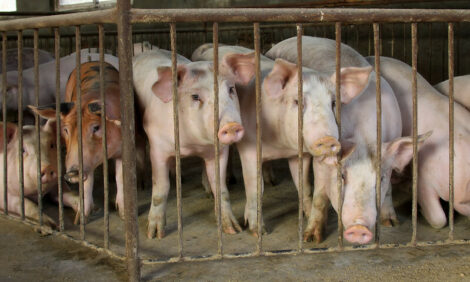



Researchers expand understanding of virus transmission in feed
As African swine fever (ASF) virus continues to march across the globe, the US pork sector is laser focused on keeping it from reaching the homeland.More answers are coming into view thanks to lessons learned from the 2013 porcine epidemic diarrhea virus (PEDV) outbreak and groundbreaking research on the risks associated with feed and feed ingredients.
“ASF is coming; it’s in the feed source,” said Scott Dee, DVM, PhD, director of Pipestone Applied Research at the 2019 American Association of Swine Veterinarians conference.
“So, we have to get ready.”
Questions about feed as a transmission risk first caught the attention of Dee and researchers from South Dakota State (SDSU) and Kansas State (KSU) universities in 2014, primarily because PEDv had spread to nearly all pig production states within 8 weeks of it entering the US. Now, with ASF knocking on the door, this cooperative research team wanted to investigate whether feed could be a vector for foreign animal diseases (FADs), including ASF virus.
The research was expanded to include 11 viruses, including Senecavirus A (SVA), as a surrogate for foot-and-mouth disease (FMD). Because KSU houses the Biosecurity Research Institute, a Biosafety Level III laboratory, they could directly study ASF virus (Georgia 2007 isolate, currently circulating in Asia), classical swine fever virus and Chinese pseudorabies.
“Thanks to the funding of the Swine Health Information Center (SHIC), we were able to partner with [KSU’s] Dr. Niederwerder and her expert team, allowing us to work with the actual agents in place of surrogates,” Dee said.
The cooperating research team set out on a three-stage search for answers:
- Could these viruses survive simulated trans-Pacific or trans-Atlantic shipments in feed and/or feed ingredients?
- Could the viruses be transmitted through contaminated feed and/or feed ingredients and infect pigs in the US?
- What tools or actions could mitigate the risk of virus introduction and spread?
Viruses survive the trip
In a study using a transboundary model that simulated transport of ingredients from China to the US, the researchers learned that PEDV can survive the 30+-day oceanic journey in some feed and/or feed ingredients. Additional research has since confirmed that ASF and SVA viruses are equally stable.
The researchers looked at complete feed and feed ingredients that are commonly imported into the US, primarily from China. The ingredients included: soy oil cake, distillers’ dried grains with solubles, dry and moist pet foods, conventional and organic soybean meal, pork sausage casings, lysine hydrochloride, choline chloride and vitamin D.
SVA was the hardiest virus, noted Megan Niederwerder, DVM, PhD, Kansas State University, having been recovered in 11 of the 12 test ingredients and feed, while ASF virus survived in nine of the ingredients.
“Considering SVA as a surrogate for FMD virus, the viruses that survive in the highest proportion of feed ingredients are also considered to be the top pathogens in the SHIC Swine Disease Matrix,” she noted. “Classical swine fever virus and pseudorabies also survive in some feed ingredients, but those experiments are ongoing.”
There was wide variation in virus viability, dependent on the virus’ properties as well as those of the ingredients. Researchers noted that high-risk combinations seem to depend on “the right virus paired with the right ingredient.”
More viruses did survive in conventional soybean meal, lysine hydrochloride, choline chloride, vitamin D and pork sausage casings. But the most striking example was the difference between conventional and organic soybean meal, with the conventional variety accounting for more virus survivability. Researchers noted one possible explanation could be the low-fat, high-protein content of conventional versus organic soybean meal, but that is not a definitive conclusion.
“This was groundbreaking work that, for the first time, provided data suggesting that feed ingredients could be vehicles for virus movement around the world,” Dee said. “Nobody had done this before, and it opened an entirely new area of investigation.”
ASF exposure via feed and liquid
Moving on to stage two, groundbreaking research has now confirmed that ASF virus can be transmitted to pigs through feed and liquid. The goals were to determine the infection probability of ASF virus at varying concentrations, as well as determine the minimum and median infectious doses through oral exposure during natural drinking and feeding behaviors, Niederwerder, lead researcher, told Pig Health Today.
“We know that ASF virus can be transmitted through direct contact between wild and domestic swine, contaminated pork products, ticks and swill feeding,” she added. “However, we did not know if it could be transmitted through natural consumption of plant-based complete feed or liquid.”
For the study, individually housed 7- to 8-week-old pigs were exposed to a single dose of ASF virus ranging from 100 TCID50 to 108 TCID50 in small volumes of liquid media (100 ml) or complete feed (100 g). The feed was a corn and soybean meal diet with no animal-based products.
At 5 days post-exposure, pigs were euthanized and assessed for ASF virus infection by polymerase chain reaction test and virus isolation. The results showed that the minimum infectious dose was lowest in liquid at 100 TCID50; for complete feed, it was 104 TCID50. The median infectious dose was 101.0 TCID50 for liquid and 106.8 TCID50 for feed.
“Even at the lowest dose we can confidently administer to pigs, approximately 40 percent of the pigs became infected when the virus was consumed in liquid,” Niederwerder said. “An acutely infected pig could easily be shedding volumes of virus within this range - and likely much higher.”
Researchers also looked at modelling repeated exposures that would occur in the field through typical consumption patterns for both liquid and feed. They found that at all ASF virus dosage levels, the probability of infection increased as the number of exposures increased. This is significant, because pigs would consume contaminated feed or liquid repeatedly and, depending on the pigs’ age, at higher volumes (>100 g and >100 ml) than what was tested.
“For example, at 104 TCID50 virus there is a 25 percent infection probability after one exposure; after 10 exposures, it’s nearly 100 percent,” Niederwerder noted. Even though liquid had a lower minimum infectious dose, feed may be more of a concern, because “a contaminated feed batch could be distributed widely to multiple farm sites, provide feed for several days and reach many pigs.”
Although it’s now known that ASF virus can survive more than 30 days in feed and/or feed ingredients, there is ongoing research to determine how long it remains infectious. “We need to consider that feed is one of the ways that ASF virus can enter the US herd,” Niederwerder said. “It’s not the only way, but we need to be aware and have preventative procedures to protect the US swine herd.”
Mitigation steps are the next priority
Risk mitigation is stage three of the ongoing research effort. This includes building the dataset for the ASF virus’ half-life to refine storage recommendations for feed processing to reduce the risk of transmission. Notably, the pork industry groups do offer holding-time recommendations based on current knowledge.
“We know the virus is susceptible to high temperatures in meat and other matrices, so there should be time and temperature levels that we can use with feed ingredients to inactivate the virus,” Niederwerder noted.
Currently, producers and feed manufacturers could begin to import ingredients from countries that pose less ASF virus risk, as well as consider whether there are ingredients that can be substituted or eliminated. Again, the pork industry groups provide a Feed Ingredient Decision Tree to help producers work through the process with their feed suppliers to minimise the risk from feed ingredients.
Take feed risk seriously
Having spent time in China, Dee relayed that producers there are taking the feed risk seriously. For example, he noted that they are testing 250 samples a day and have a dataset of more than 11,000 samples. “Out of those samples, they found a small number of positive samples - 1 percent to 2 percent ASF virus in complete feed and ingredients,” he said. “It shows how hard you have to look to find it.”
Even more eye-opening was the environmental contamination that they identified. “They found it [ASF virus] at the mill, in trucks, on people, shoes - it’s like a nuclear bomb. There’s a cloud over everything,” Dee added.
Chemical mitigants may be an option, and Dee and Diego Diel, DVM, PhD, South Dakota State University researcher, have studies underway with other viruses. The project is set up in the Pipestone Veterinary Services’ research facility, with six groups of 100 pigs in a room. Each room has its own bin to ensure that virus-infected and non-infected feed remain segregated. Multiple candidate products from more than 10 companies are being tested.
Dee explained that the virus-exposure process is designed to be as natural as possible. SVA, porcine reproductive and respiratory syndrome virus (PRRSv) and PED viruses (100 ml each, 105) are inoculated into 1-pound blocks of ice, which are dropped into the feed bins, left to melt and permeate the feed. They swabbed the environment to see if the viruses entered the room through feed, tested fluid samples from pigs and conducted necropsies.
The preliminary results look promising for PRRS and SVA viruses; however, there was less response for PEDv. “All the products did a nice job of mitigating the viruses,” Dee noted. “They helped; they reduced the viral load and risk of infection, but there’s no silver bullet here.”
The plan is to look at 10 additional mitigants before the year’s end. Dee and Diel will then hand the information over to Niederwerder who will run them through ASF virus testing.
“I’ve deemed 2019 the year of the mitigant,” Dee said. “Producers believe in the risk of feed, and they don’t want ASF or other FADs to have a chance to enter that way. They’re using science to make decisions, and we’re moving ahead to take on a challenge we know is coming.”






